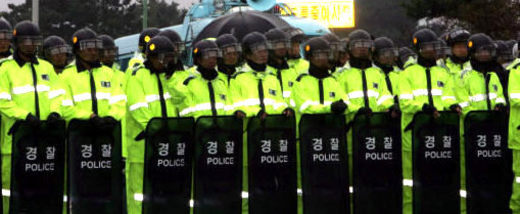 |
|
A riot police squad
|
Rates of injury, suicide higher for those completing their mandatory military service as police
As the number of public demonstrations is on the rise in South Korea, riot police are being put under greater stress. However, the treatment given to the officers is hardly enough to relieve them from the growing dangers of their job.
The barracks housing the riot police - a corps made up of Korean males serving their mandatory military service - were built more than 20 years ago, and are crowded with double bunk beds. The room to relax is a rare commodity.
This is a common scene for officers serving their military service as police officers.
Being assigned to the riot police squad or the enlisted police service, in which state service draftees work alongside regular police officers as assistants, are two ways to fulfill one's mandatory military service.
Last October, National Assemblyman Kim Nak-soon of the Uri Party disclosed the average sleeping space appropriated to the riot and enlisted police officers to the National Assembly. Under Seoul Metropolitan Police Agency's command, this space is 2.64 square meters, smaller than the room appropriated to jail inmates, which is 3.14 square meters. When it comes to enlisted officers, who are assigned to patrolling duties, it gets more cramped. In their quarters, 110 officers sleep in a 105-square-meter room, slightly less than one square meter per person. Improvement on the drafted officers' living facilities is progressing at a snail's pace. There are 59 units of riot police nationwide, and the budget for facility improvement is appropriated annually. However, the National Police Agency has not been spending its full budget, which ranges from 1.7 to 4.4 billion won, or 36 to 51 of the annual budget, since 2002. The police says, "there are many riot police barracks located in the mountainous areas, thus the construction work was postponed in the event of floods and heavy snow. We will schedule the construction work more practically, plan the budget more efficiently and spend it when it's needed." The Seoul Metropolitan Police Agency says that drafted and riot officers work between 8.5 and 9.2 hours per day, but the actual working hours, including time spend standing by along with mobilization hours, shows a huge disparity with the official figures. According to a study commissioned by National Human Rights Commission and conducted by Cheonan University on 1,300 drafted officers in 26 units nationwide, 41.8 percent said they have "less than 2 hours per day to rest," with 26 percent answering that they "work for 11 hours or longer per day." More and more drafted officers are suffering from physical and mental problems. The number of drafted police officers wounded in dealing with demonstrations in 2002 was 923, but it recorded a 33-percent increase to 1,232 last year. One-hundred nine drafted officers assigned to the Seoul Metropolitan Police Agency were treated for mental disorders last year, which is 2.3 times higher than the figure three years ago. The suicide rate of drafted police officers has always been higher than that of drafted soldiers. The rate for drafted police officers was 2.3 per 10,000 persons in 2003, and 1.27 and 1.48 in 2004 and 2005, respectively, while the suicide rate for drafted soldiers stood at 1.32, 1.26, and 0.71 per 10,000 people in the same years. Lee Jeong-wha, the representative of Parents of Drafted Police Officers, says that "while violent demonstrations remain as prevalent as they used to be, riot and enlisted police officers' working conditions have not improved. What is worse is that [the whole situation] is causing our boys to grow insensitive to violence." The legal status of drafted police officers remains unclear. The riot police and enlisted police forces were established in 1976 and 1982 by several related laws, and as of December this year, there have been a total of about 38,000 drafted police officers. The law says riot policemen are to be responsible for anti-guerilla operations, and enlisted officers are to support policing activities. However, in reality, 80 to 90 percent of drafted police officers are assigned to deal with demonstrations, whether acting as riot or enlisted police officers. In 1995, the Constitutional Court ruled that it is constitutional to assign military draftees to deal with demonstrations. But four out of nine judges at the ruling had a minority opinion which said, "the duty of military draftees assigned to be riot police should be to carry out anti-guerilla operations. Dealing with demonstrations should be seen as a duty purely meant for regular police officers, and should not be a duty relegated to drafted officers." The unconstitutionality argument could be brought up again at any time, as all adult males in South Korea are required to serve in the military, but for national defense duty - unrelated to dealing with civil demonstrations, critics of the current system say. Song Gi-chun, professor of law at Jeonbuk University, says "to order riot police to deter demonstrations is no different from ordering them to carry out missions for which they are not responsible. It is a violation of their right to act according to their will. Applied to the U.N.'s International Covenant on Civil and Political Rights and International Labour Organisation standards, this can be seen as forced labor." Please direct questions or comments to [englishhani@hani.co.kr]





